Discussions on Different Activities in Unit 7
VerifiedAdded on 2023/06/10
|12
|4577
|150
AI Summary
This post contains discussions from different students on various activities in Unit 7 including finding data types, error handling, and try/catch blocks. The students share their views and provide examples to support their arguments. They also provide solutions to common errors encountered while working with PHP and MySQL. The post is relevant to students studying Unit 7 in any college or university.
Contribute Materials
Your contribution can guide someone’s learning journey. Share your
documents today.

PLAGIARISM DECLARATION
This report presents a discussion from different students on different activities of the task. The
discussions have been copied as they are and no changes have been done to them. My views on the
discussions are purely mine and have not been copied from any other source.
This report presents a discussion from different students on different activities of the task. The
discussions have been copied as they are and no changes have been done to them. My views on the
discussions are purely mine and have not been copied from any other source.
Secure Best Marks with AI Grader
Need help grading? Try our AI Grader for instant feedback on your assignments.

Respond to these students post: Do not simply write: I agree...move the conversations forward.
Again it will be good to disagree with some of the posts with reasons too.
1) Activity 7.1: Find out the data types
COLLAPSE
Since the BLOBs hold large amounts of data, up to 65.5 KB, this data type can be used for storing
multimedia files, audio files, video files, e.g. TV programs or films.
A fixed size content provides better system performance since it allows faster calculation within a
database. Since CHAR is fixed length, it is more suitable to use it for a predefined fixed size data up
to 20 characters, such as phone numbers, postcodes, ID numbers, etc.
I agree with the student for the usage of BLOB data types to store large media files including files,
audio files or images. However based on the MySQL documentation the maximum size of a file
allowed for the BLOB data type is 2GB.
I agree with the student on the scenarios that CHAR is better of being used than VARCHAR because
CHAR is better used in place of VARCHAR when the data expected for the filed is of the same length
for example a filed taking Y or N character.
2) Discuss Unit 7 Activities - Unit 7.5
COLL AP SE
a) My understanding of a try/catch/throw exception handing is simply that an input is taken and
using the 'try' block it is sent to a function that evaluates it according to given criteria and, if this
fails, then a catch statement is 'thrown' which gives an error statement (using $e->getMessage()
which is part of the functionality of the exception object) otherwise if the evaluation passes then
control is returned back to the "try" block and the program continues on.
b) There are a variety of areas in an application that errors can be caught i.e.,
Errors on validation
Data is missing
Failing to connect with databases
The real problem is that there are probably a multitude of places where you could put a specific
try/catch/throw error exception handler but these would be numerous and in a really complex
programme, no matter how hard you try and debug your code, some bugs may still slip through
and so you may decide to put a general exception handler in place so that the error handling is a
little bit more user-friendly than the standard PHP error handing.
The reference below is quite useful since it provide a user friendly break down of the PHP
exception handling.
Reference
w3schools. 2018. PHP Exception Handing. w3schools.com. [ONLINE] Available
at: https://www.w3schools.com/php/php_exception.asp [accessed on 10/07/2018]
3) RE: Discuss Unit 7 Activities - Unit 7.5
COLL AP SE
Hi Mark,
Again it will be good to disagree with some of the posts with reasons too.
1) Activity 7.1: Find out the data types
COLLAPSE
Since the BLOBs hold large amounts of data, up to 65.5 KB, this data type can be used for storing
multimedia files, audio files, video files, e.g. TV programs or films.
A fixed size content provides better system performance since it allows faster calculation within a
database. Since CHAR is fixed length, it is more suitable to use it for a predefined fixed size data up
to 20 characters, such as phone numbers, postcodes, ID numbers, etc.
I agree with the student for the usage of BLOB data types to store large media files including files,
audio files or images. However based on the MySQL documentation the maximum size of a file
allowed for the BLOB data type is 2GB.
I agree with the student on the scenarios that CHAR is better of being used than VARCHAR because
CHAR is better used in place of VARCHAR when the data expected for the filed is of the same length
for example a filed taking Y or N character.
2) Discuss Unit 7 Activities - Unit 7.5
COLL AP SE
a) My understanding of a try/catch/throw exception handing is simply that an input is taken and
using the 'try' block it is sent to a function that evaluates it according to given criteria and, if this
fails, then a catch statement is 'thrown' which gives an error statement (using $e->getMessage()
which is part of the functionality of the exception object) otherwise if the evaluation passes then
control is returned back to the "try" block and the program continues on.
b) There are a variety of areas in an application that errors can be caught i.e.,
Errors on validation
Data is missing
Failing to connect with databases
The real problem is that there are probably a multitude of places where you could put a specific
try/catch/throw error exception handler but these would be numerous and in a really complex
programme, no matter how hard you try and debug your code, some bugs may still slip through
and so you may decide to put a general exception handler in place so that the error handling is a
little bit more user-friendly than the standard PHP error handing.
The reference below is quite useful since it provide a user friendly break down of the PHP
exception handling.
Reference
w3schools. 2018. PHP Exception Handing. w3schools.com. [ONLINE] Available
at: https://www.w3schools.com/php/php_exception.asp [accessed on 10/07/2018]
3) RE: Discuss Unit 7 Activities - Unit 7.5
COLL AP SE
Hi Mark,
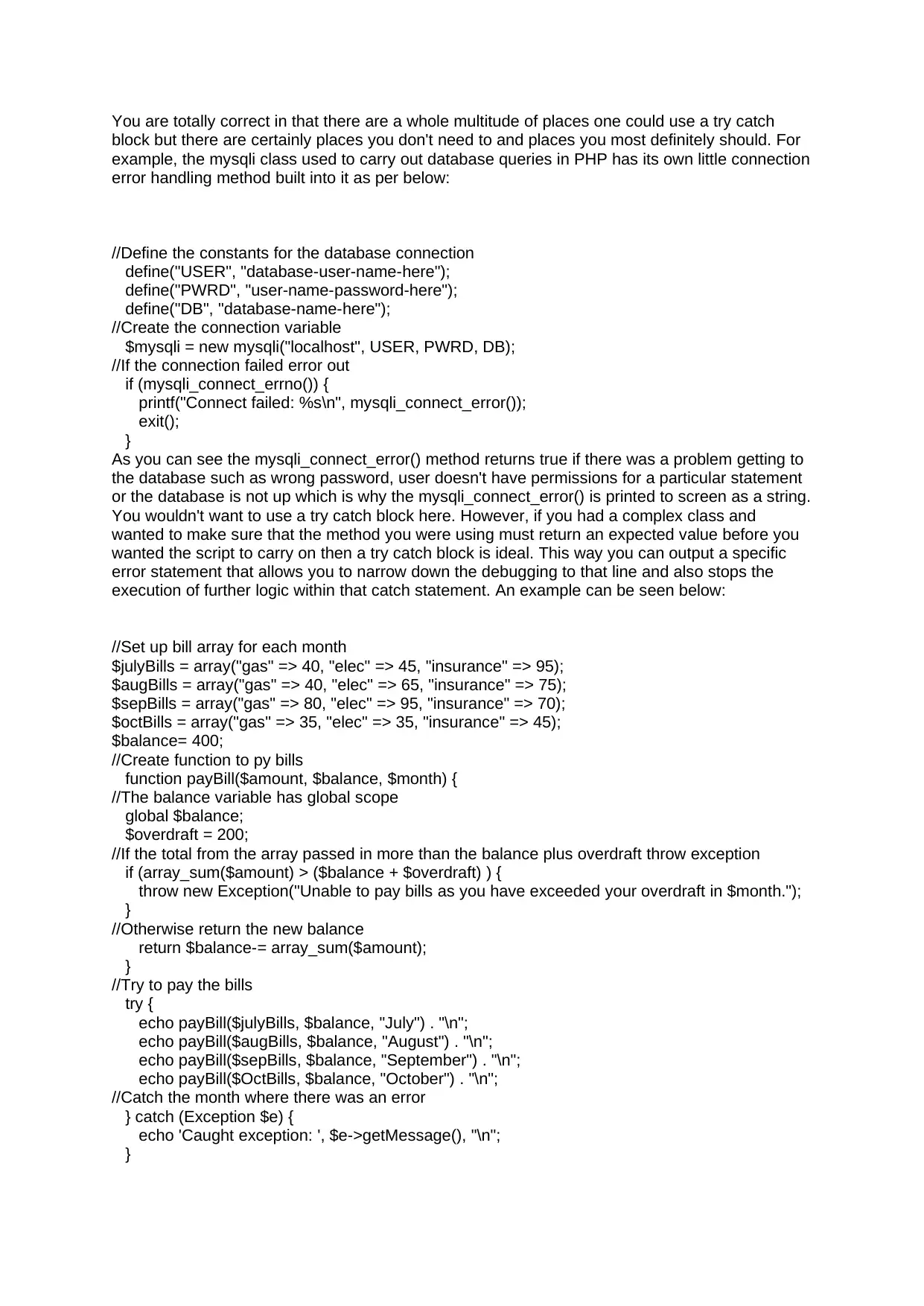
You are totally correct in that there are a whole multitude of places one could use a try catch
block but there are certainly places you don't need to and places you most definitely should. For
example, the mysqli class used to carry out database queries in PHP has its own little connection
error handling method built into it as per below:
//Define the constants for the database connection
define("USER", "database-user-name-here");
define("PWRD", "user-name-password-here");
define("DB", "database-name-here");
//Create the connection variable
$mysqli = new mysqli("localhost", USER, PWRD, DB);
//If the connection failed error out
if (mysqli_connect_errno()) {
printf("Connect failed: %s\n", mysqli_connect_error());
exit();
}
As you can see the mysqli_connect_error() method returns true if there was a problem getting to
the database such as wrong password, user doesn't have permissions for a particular statement
or the database is not up which is why the mysqli_connect_error() is printed to screen as a string.
You wouldn't want to use a try catch block here. However, if you had a complex class and
wanted to make sure that the method you were using must return an expected value before you
wanted the script to carry on then a try catch block is ideal. This way you can output a specific
error statement that allows you to narrow down the debugging to that line and also stops the
execution of further logic within that catch statement. An example can be seen below:
//Set up bill array for each month
$julyBills = array("gas" => 40, "elec" => 45, "insurance" => 95);
$augBills = array("gas" => 40, "elec" => 65, "insurance" => 75);
$sepBills = array("gas" => 80, "elec" => 95, "insurance" => 70);
$octBills = array("gas" => 35, "elec" => 35, "insurance" => 45);
$balance= 400;
//Create function to py bills
function payBill($amount, $balance, $month) {
//The balance variable has global scope
global $balance;
$overdraft = 200;
//If the total from the array passed in more than the balance plus overdraft throw exception
if (array_sum($amount) > ($balance + $overdraft) ) {
throw new Exception("Unable to pay bills as you have exceeded your overdraft in $month.");
}
//Otherwise return the new balance
return $balance-= array_sum($amount);
}
//Try to pay the bills
try {
echo payBill($julyBills, $balance, "July") . "\n";
echo payBill($augBills, $balance, "August") . "\n";
echo payBill($sepBills, $balance, "September") . "\n";
echo payBill($OctBills, $balance, "October") . "\n";
//Catch the month where there was an error
} catch (Exception $e) {
echo 'Caught exception: ', $e->getMessage(), "\n";
}
block but there are certainly places you don't need to and places you most definitely should. For
example, the mysqli class used to carry out database queries in PHP has its own little connection
error handling method built into it as per below:
//Define the constants for the database connection
define("USER", "database-user-name-here");
define("PWRD", "user-name-password-here");
define("DB", "database-name-here");
//Create the connection variable
$mysqli = new mysqli("localhost", USER, PWRD, DB);
//If the connection failed error out
if (mysqli_connect_errno()) {
printf("Connect failed: %s\n", mysqli_connect_error());
exit();
}
As you can see the mysqli_connect_error() method returns true if there was a problem getting to
the database such as wrong password, user doesn't have permissions for a particular statement
or the database is not up which is why the mysqli_connect_error() is printed to screen as a string.
You wouldn't want to use a try catch block here. However, if you had a complex class and
wanted to make sure that the method you were using must return an expected value before you
wanted the script to carry on then a try catch block is ideal. This way you can output a specific
error statement that allows you to narrow down the debugging to that line and also stops the
execution of further logic within that catch statement. An example can be seen below:
//Set up bill array for each month
$julyBills = array("gas" => 40, "elec" => 45, "insurance" => 95);
$augBills = array("gas" => 40, "elec" => 65, "insurance" => 75);
$sepBills = array("gas" => 80, "elec" => 95, "insurance" => 70);
$octBills = array("gas" => 35, "elec" => 35, "insurance" => 45);
$balance= 400;
//Create function to py bills
function payBill($amount, $balance, $month) {
//The balance variable has global scope
global $balance;
$overdraft = 200;
//If the total from the array passed in more than the balance plus overdraft throw exception
if (array_sum($amount) > ($balance + $overdraft) ) {
throw new Exception("Unable to pay bills as you have exceeded your overdraft in $month.");
}
//Otherwise return the new balance
return $balance-= array_sum($amount);
}
//Try to pay the bills
try {
echo payBill($julyBills, $balance, "July") . "\n";
echo payBill($augBills, $balance, "August") . "\n";
echo payBill($sepBills, $balance, "September") . "\n";
echo payBill($OctBills, $balance, "October") . "\n";
//Catch the month where there was an error
} catch (Exception $e) {
echo 'Caught exception: ', $e->getMessage(), "\n";
}
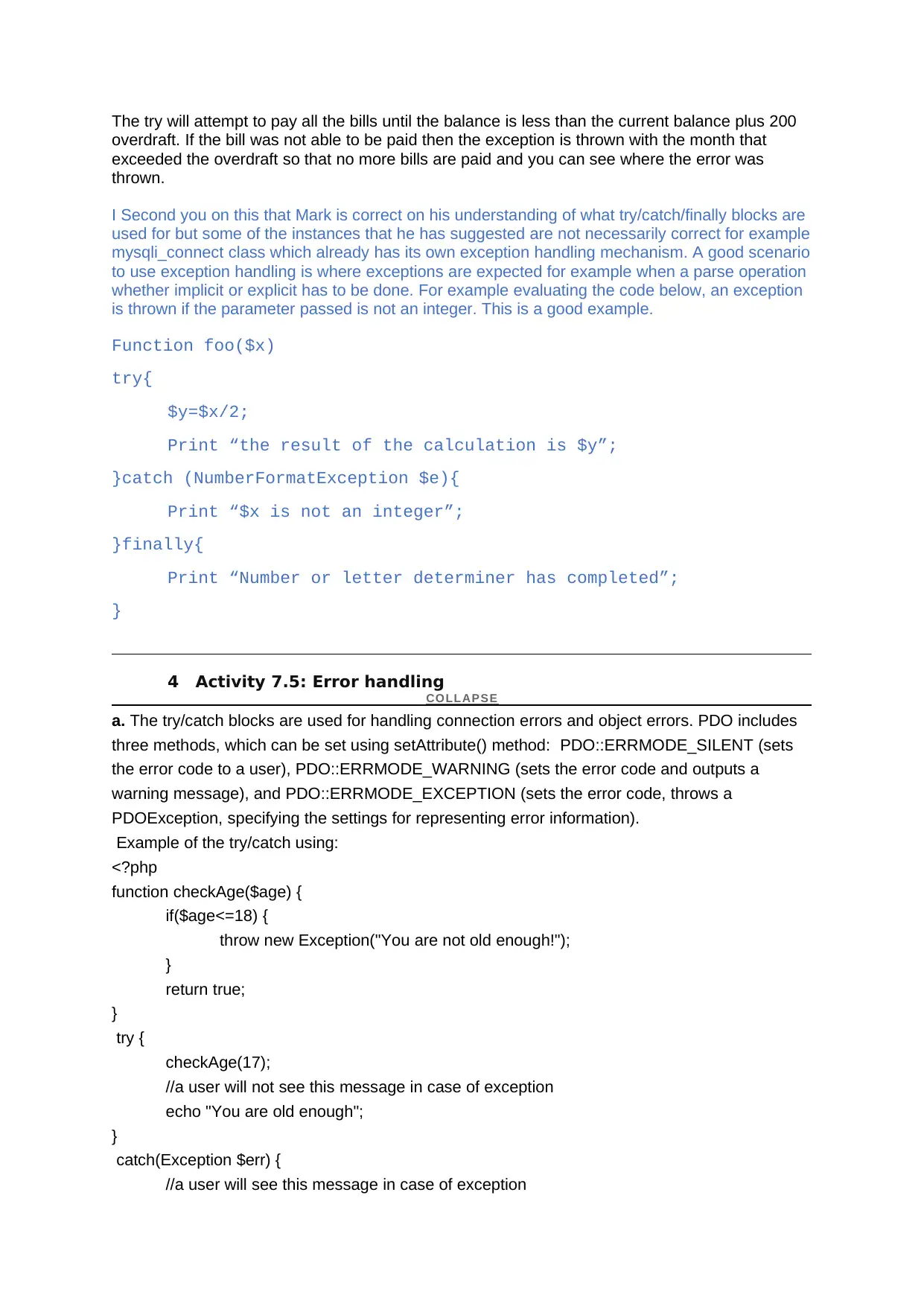
The try will attempt to pay all the bills until the balance is less than the current balance plus 200
overdraft. If the bill was not able to be paid then the exception is thrown with the month that
exceeded the overdraft so that no more bills are paid and you can see where the error was
thrown.
I Second you on this that Mark is correct on his understanding of what try/catch/finally blocks are
used for but some of the instances that he has suggested are not necessarily correct for example
mysqli_connect class which already has its own exception handling mechanism. A good scenario
to use exception handling is where exceptions are expected for example when a parse operation
whether implicit or explicit has to be done. For example evaluating the code below, an exception
is thrown if the parameter passed is not an integer. This is a good example.
Function foo($x)
try{
$y=$x/2;
Print “the result of the calculation is $y”;
}catch (NumberFormatException $e){
Print “$x is not an integer”;
}finally{
Print “Number or letter determiner has completed”;
}
4 Activity 7.5: Error handling
COLL AP SE
a. The try/catch blocks are used for handling connection errors and object errors. PDO includes
three methods, which can be set using setAttribute() method: PDO::ERRMODE_SILENT (sets
the error code to a user), PDO::ERRMODE_WARNING (sets the error code and outputs a
warning message), and PDO::ERRMODE_EXCEPTION (sets the error code, throws a
PDOException, specifying the settings for representing error information).
Example of the try/catch using:
<?php
function checkAge($age) {
if($age<=18) {
throw new Exception("You are not old enough!");
}
return true;
}
try {
checkAge(17);
//a user will not see this message in case of exception
echo "You are old enough";
}
catch(Exception $err) {
//a user will see this message in case of exception
overdraft. If the bill was not able to be paid then the exception is thrown with the month that
exceeded the overdraft so that no more bills are paid and you can see where the error was
thrown.
I Second you on this that Mark is correct on his understanding of what try/catch/finally blocks are
used for but some of the instances that he has suggested are not necessarily correct for example
mysqli_connect class which already has its own exception handling mechanism. A good scenario
to use exception handling is where exceptions are expected for example when a parse operation
whether implicit or explicit has to be done. For example evaluating the code below, an exception
is thrown if the parameter passed is not an integer. This is a good example.
Function foo($x)
try{
$y=$x/2;
Print “the result of the calculation is $y”;
}catch (NumberFormatException $e){
Print “$x is not an integer”;
}finally{
Print “Number or letter determiner has completed”;
}
4 Activity 7.5: Error handling
COLL AP SE
a. The try/catch blocks are used for handling connection errors and object errors. PDO includes
three methods, which can be set using setAttribute() method: PDO::ERRMODE_SILENT (sets
the error code to a user), PDO::ERRMODE_WARNING (sets the error code and outputs a
warning message), and PDO::ERRMODE_EXCEPTION (sets the error code, throws a
PDOException, specifying the settings for representing error information).
Example of the try/catch using:
<?php
function checkAge($age) {
if($age<=18) {
throw new Exception("You are not old enough!");
}
return true;
}
try {
checkAge(17);
//a user will not see this message in case of exception
echo "You are old enough";
}
catch(Exception $err) {
//a user will see this message in case of exception
Secure Best Marks with AI Grader
Need help grading? Try our AI Grader for instant feedback on your assignments.
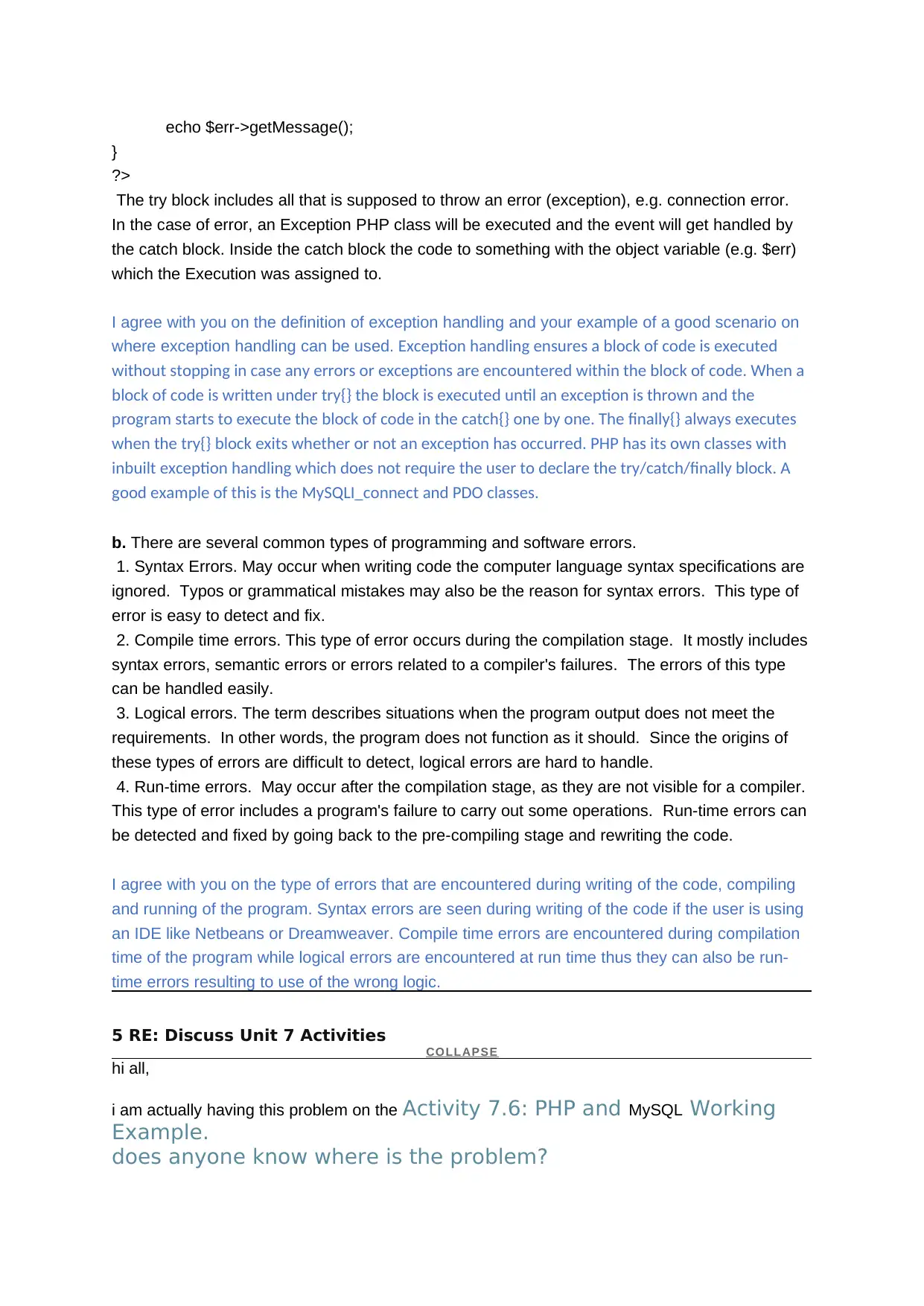
echo $err->getMessage();
}
?>
The try block includes all that is supposed to throw an error (exception), e.g. connection error.
In the case of error, an Exception PHP class will be executed and the event will get handled by
the catch block. Inside the catch block the code to something with the object variable (e.g. $err)
which the Execution was assigned to.
I agree with you on the definition of exception handling and your example of a good scenario on
where exception handling can be used. Exception handling ensures a block of code is executed
without stopping in case any errors or exceptions are encountered within the block of code. When a
block of code is written under try{} the block is executed until an exception is thrown and the
program starts to execute the block of code in the catch{} one by one. The finally{} always executes
when the try{} block exits whether or not an exception has occurred. PHP has its own classes with
inbuilt exception handling which does not require the user to declare the try/catch/finally block. A
good example of this is the MySQLI_connect and PDO classes.
b. There are several common types of programming and software errors.
1. Syntax Errors. May occur when writing code the computer language syntax specifications are
ignored. Typos or grammatical mistakes may also be the reason for syntax errors. This type of
error is easy to detect and fix.
2. Compile time errors. This type of error occurs during the compilation stage. It mostly includes
syntax errors, semantic errors or errors related to a compiler's failures. The errors of this type
can be handled easily.
3. Logical errors. The term describes situations when the program output does not meet the
requirements. In other words, the program does not function as it should. Since the origins of
these types of errors are difficult to detect, logical errors are hard to handle.
4. Run-time errors. May occur after the compilation stage, as they are not visible for a compiler.
This type of error includes a program's failure to carry out some operations. Run-time errors can
be detected and fixed by going back to the pre-compiling stage and rewriting the code.
I agree with you on the type of errors that are encountered during writing of the code, compiling
and running of the program. Syntax errors are seen during writing of the code if the user is using
an IDE like Netbeans or Dreamweaver. Compile time errors are encountered during compilation
time of the program while logical errors are encountered at run time thus they can also be run-
time errors resulting to use of the wrong logic.
5 RE: Discuss Unit 7 Activities COLL AP SE
hi all,
i am actually having this problem on the Activity 7.6: PHP and MySQL Working
Example.
does anyone know where is the problem?
}
?>
The try block includes all that is supposed to throw an error (exception), e.g. connection error.
In the case of error, an Exception PHP class will be executed and the event will get handled by
the catch block. Inside the catch block the code to something with the object variable (e.g. $err)
which the Execution was assigned to.
I agree with you on the definition of exception handling and your example of a good scenario on
where exception handling can be used. Exception handling ensures a block of code is executed
without stopping in case any errors or exceptions are encountered within the block of code. When a
block of code is written under try{} the block is executed until an exception is thrown and the
program starts to execute the block of code in the catch{} one by one. The finally{} always executes
when the try{} block exits whether or not an exception has occurred. PHP has its own classes with
inbuilt exception handling which does not require the user to declare the try/catch/finally block. A
good example of this is the MySQLI_connect and PDO classes.
b. There are several common types of programming and software errors.
1. Syntax Errors. May occur when writing code the computer language syntax specifications are
ignored. Typos or grammatical mistakes may also be the reason for syntax errors. This type of
error is easy to detect and fix.
2. Compile time errors. This type of error occurs during the compilation stage. It mostly includes
syntax errors, semantic errors or errors related to a compiler's failures. The errors of this type
can be handled easily.
3. Logical errors. The term describes situations when the program output does not meet the
requirements. In other words, the program does not function as it should. Since the origins of
these types of errors are difficult to detect, logical errors are hard to handle.
4. Run-time errors. May occur after the compilation stage, as they are not visible for a compiler.
This type of error includes a program's failure to carry out some operations. Run-time errors can
be detected and fixed by going back to the pre-compiling stage and rewriting the code.
I agree with you on the type of errors that are encountered during writing of the code, compiling
and running of the program. Syntax errors are seen during writing of the code if the user is using
an IDE like Netbeans or Dreamweaver. Compile time errors are encountered during compilation
time of the program while logical errors are encountered at run time thus they can also be run-
time errors resulting to use of the wrong logic.
5 RE: Discuss Unit 7 Activities COLL AP SE
hi all,
i am actually having this problem on the Activity 7.6: PHP and MySQL Working
Example.
does anyone know where is the problem?
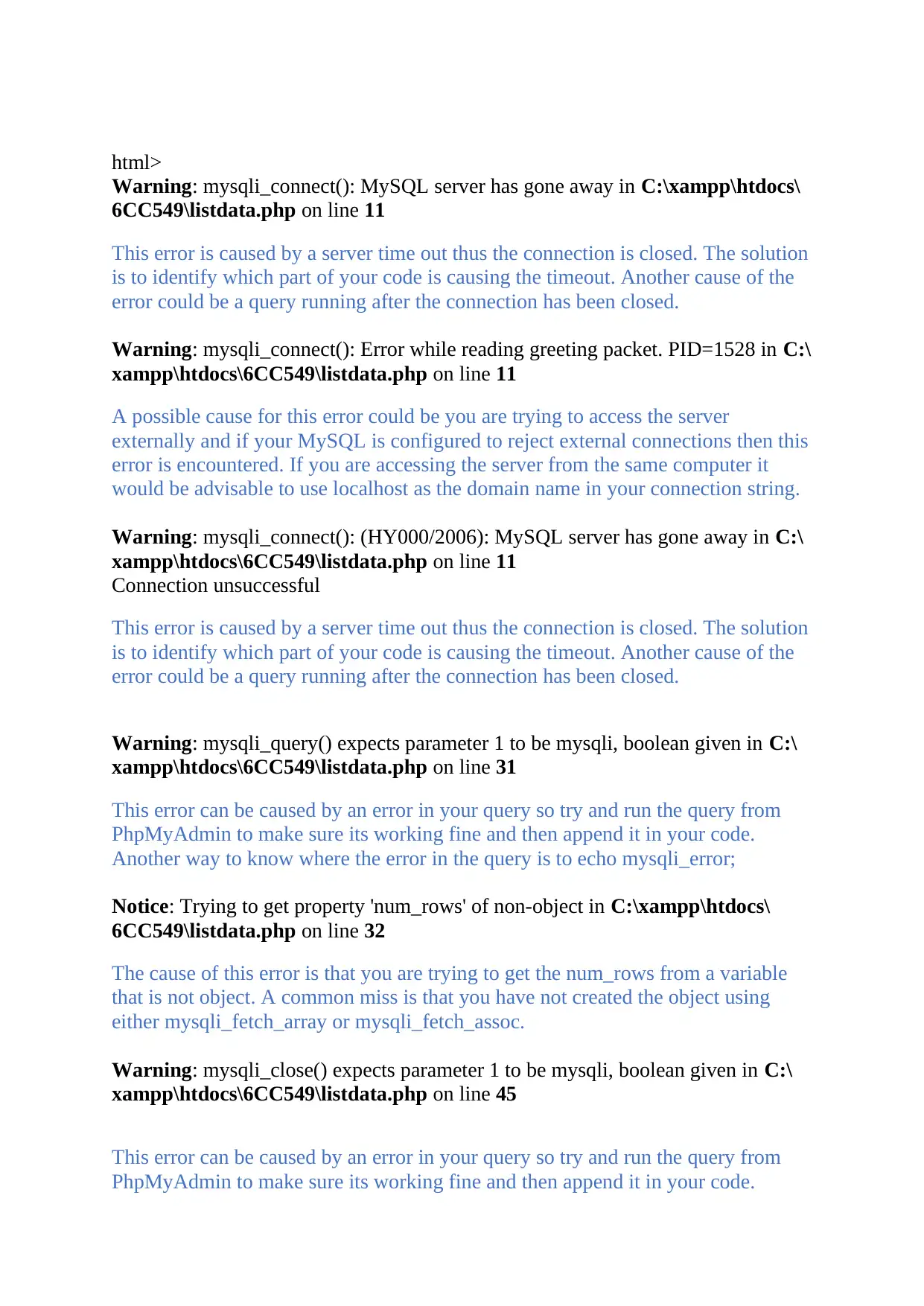
html>
Warning: mysqli_connect(): MySQL server has gone away in C:\xampp\htdocs\
6CC549\listdata.php on line 11
This error is caused by a server time out thus the connection is closed. The solution
is to identify which part of your code is causing the timeout. Another cause of the
error could be a query running after the connection has been closed.
Warning: mysqli_connect(): Error while reading greeting packet. PID=1528 in C:\
xampp\htdocs\6CC549\listdata.php on line 11
A possible cause for this error could be you are trying to access the server
externally and if your MySQL is configured to reject external connections then this
error is encountered. If you are accessing the server from the same computer it
would be advisable to use localhost as the domain name in your connection string.
Warning: mysqli_connect(): (HY000/2006): MySQL server has gone away in C:\
xampp\htdocs\6CC549\listdata.php on line 11
Connection unsuccessful
This error is caused by a server time out thus the connection is closed. The solution
is to identify which part of your code is causing the timeout. Another cause of the
error could be a query running after the connection has been closed.
Warning: mysqli_query() expects parameter 1 to be mysqli, boolean given in C:\
xampp\htdocs\6CC549\listdata.php on line 31
This error can be caused by an error in your query so try and run the query from
PhpMyAdmin to make sure its working fine and then append it in your code.
Another way to know where the error in the query is to echo mysqli_error;
Notice: Trying to get property 'num_rows' of non-object in C:\xampp\htdocs\
6CC549\listdata.php on line 32
The cause of this error is that you are trying to get the num_rows from a variable
that is not object. A common miss is that you have not created the object using
either mysqli_fetch_array or mysqli_fetch_assoc.
Warning: mysqli_close() expects parameter 1 to be mysqli, boolean given in C:\
xampp\htdocs\6CC549\listdata.php on line 45
This error can be caused by an error in your query so try and run the query from
PhpMyAdmin to make sure its working fine and then append it in your code.
Warning: mysqli_connect(): MySQL server has gone away in C:\xampp\htdocs\
6CC549\listdata.php on line 11
This error is caused by a server time out thus the connection is closed. The solution
is to identify which part of your code is causing the timeout. Another cause of the
error could be a query running after the connection has been closed.
Warning: mysqli_connect(): Error while reading greeting packet. PID=1528 in C:\
xampp\htdocs\6CC549\listdata.php on line 11
A possible cause for this error could be you are trying to access the server
externally and if your MySQL is configured to reject external connections then this
error is encountered. If you are accessing the server from the same computer it
would be advisable to use localhost as the domain name in your connection string.
Warning: mysqli_connect(): (HY000/2006): MySQL server has gone away in C:\
xampp\htdocs\6CC549\listdata.php on line 11
Connection unsuccessful
This error is caused by a server time out thus the connection is closed. The solution
is to identify which part of your code is causing the timeout. Another cause of the
error could be a query running after the connection has been closed.
Warning: mysqli_query() expects parameter 1 to be mysqli, boolean given in C:\
xampp\htdocs\6CC549\listdata.php on line 31
This error can be caused by an error in your query so try and run the query from
PhpMyAdmin to make sure its working fine and then append it in your code.
Another way to know where the error in the query is to echo mysqli_error;
Notice: Trying to get property 'num_rows' of non-object in C:\xampp\htdocs\
6CC549\listdata.php on line 32
The cause of this error is that you are trying to get the num_rows from a variable
that is not object. A common miss is that you have not created the object using
either mysqli_fetch_array or mysqli_fetch_assoc.
Warning: mysqli_close() expects parameter 1 to be mysqli, boolean given in C:\
xampp\htdocs\6CC549\listdata.php on line 45
This error can be caused by an error in your query so try and run the query from
PhpMyAdmin to make sure its working fine and then append it in your code.
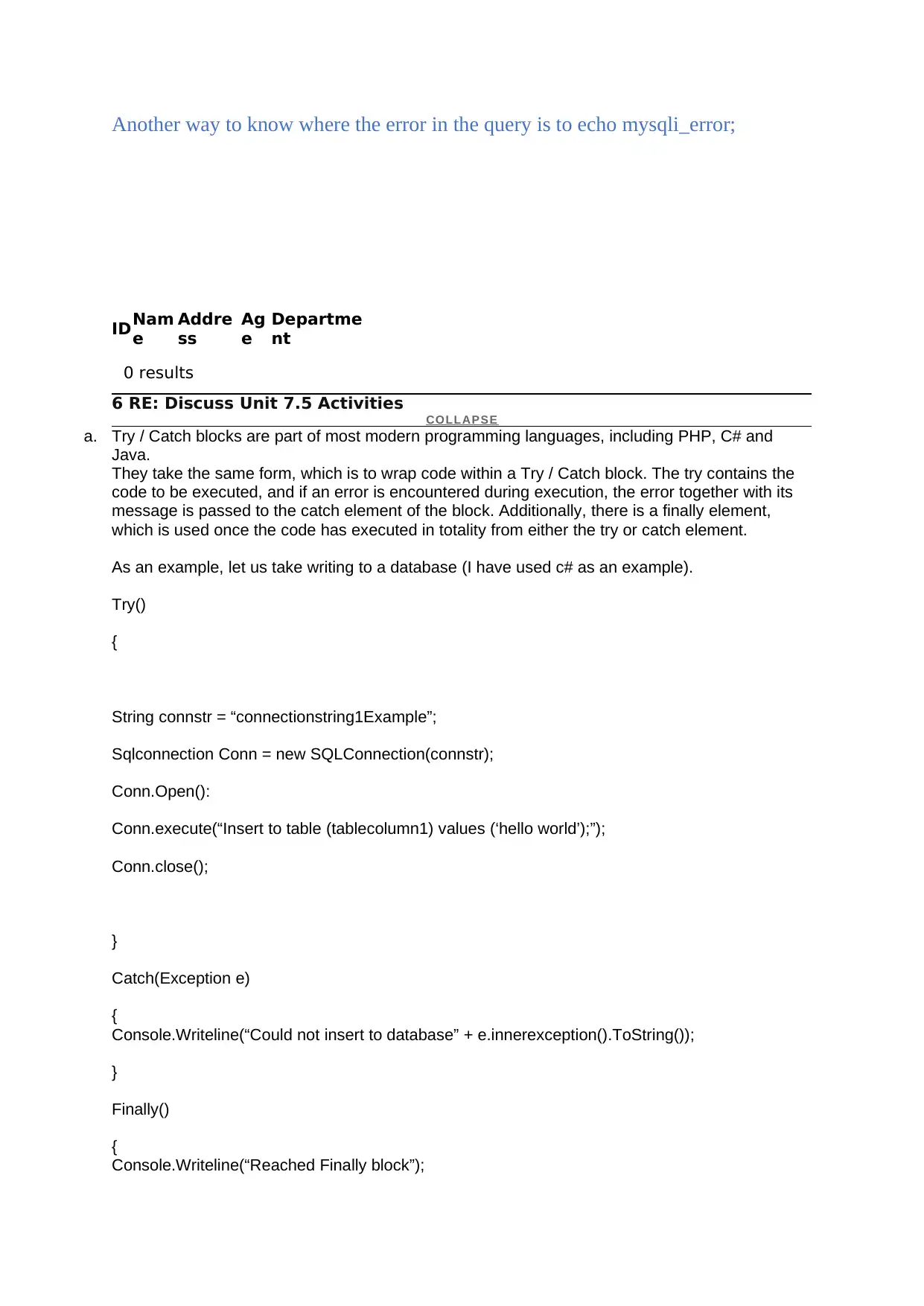
Another way to know where the error in the query is to echo mysqli_error;
IDNam
e
Addre
ss
Ag
e
Departme
nt
0 results
6 RE: Discuss Unit 7.5 Activities COLL AP SE
a. Try / Catch blocks are part of most modern programming languages, including PHP, C# and
Java.
They take the same form, which is to wrap code within a Try / Catch block. The try contains the
code to be executed, and if an error is encountered during execution, the error together with its
message is passed to the catch element of the block. Additionally, there is a finally element,
which is used once the code has executed in totality from either the try or catch element.
As an example, let us take writing to a database (I have used c# as an example).
Try()
{
String connstr = “connectionstring1Example”;
Sqlconnection Conn = new SQLConnection(connstr);
Conn.Open():
Conn.execute(“Insert to table (tablecolumn1) values (‘hello world’);”);
Conn.close();
}
Catch(Exception e)
{
Console.Writeline(“Could not insert to database” + e.innerexception().ToString());
}
Finally()
{
Console.Writeline(“Reached Finally block”);
IDNam
e
Addre
ss
Ag
e
Departme
nt
0 results
6 RE: Discuss Unit 7.5 Activities COLL AP SE
a. Try / Catch blocks are part of most modern programming languages, including PHP, C# and
Java.
They take the same form, which is to wrap code within a Try / Catch block. The try contains the
code to be executed, and if an error is encountered during execution, the error together with its
message is passed to the catch element of the block. Additionally, there is a finally element,
which is used once the code has executed in totality from either the try or catch element.
As an example, let us take writing to a database (I have used c# as an example).
Try()
{
String connstr = “connectionstring1Example”;
Sqlconnection Conn = new SQLConnection(connstr);
Conn.Open():
Conn.execute(“Insert to table (tablecolumn1) values (‘hello world’);”);
Conn.close();
}
Catch(Exception e)
{
Console.Writeline(“Could not insert to database” + e.innerexception().ToString());
}
Finally()
{
Console.Writeline(“Reached Finally block”);
Paraphrase This Document
Need a fresh take? Get an instant paraphrase of this document with our AI Paraphraser
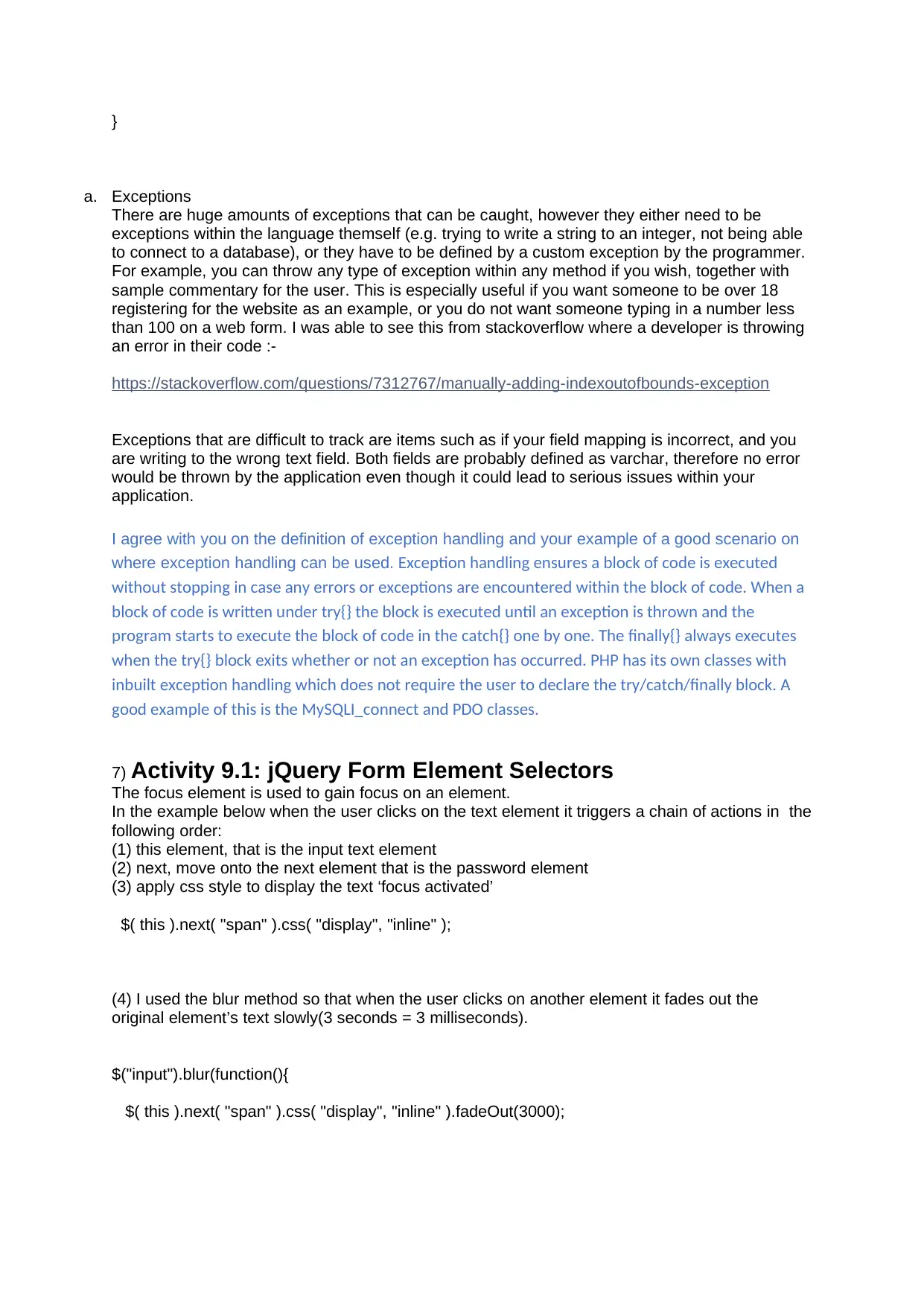
}
a. Exceptions
There are huge amounts of exceptions that can be caught, however they either need to be
exceptions within the language themself (e.g. trying to write a string to an integer, not being able
to connect to a database), or they have to be defined by a custom exception by the programmer.
For example, you can throw any type of exception within any method if you wish, together with
sample commentary for the user. This is especially useful if you want someone to be over 18
registering for the website as an example, or you do not want someone typing in a number less
than 100 on a web form. I was able to see this from stackoverflow where a developer is throwing
an error in their code :-
https://stackoverflow.com/questions/7312767/manually-adding-indexoutofbounds-exception
Exceptions that are difficult to track are items such as if your field mapping is incorrect, and you
are writing to the wrong text field. Both fields are probably defined as varchar, therefore no error
would be thrown by the application even though it could lead to serious issues within your
application.
I agree with you on the definition of exception handling and your example of a good scenario on
where exception handling can be used. Exception handling ensures a block of code is executed
without stopping in case any errors or exceptions are encountered within the block of code. When a
block of code is written under try{} the block is executed until an exception is thrown and the
program starts to execute the block of code in the catch{} one by one. The finally{} always executes
when the try{} block exits whether or not an exception has occurred. PHP has its own classes with
inbuilt exception handling which does not require the user to declare the try/catch/finally block. A
good example of this is the MySQLI_connect and PDO classes.
7) Activity 9.1: jQuery Form Element Selectors
The focus element is used to gain focus on an element.
In the example below when the user clicks on the text element it triggers a chain of actions in the
following order:
(1) this element, that is the input text element
(2) next, move onto the next element that is the password element
(3) apply css style to display the text ‘focus activated’
$( this ).next( "span" ).css( "display", "inline" );
(4) I used the blur method so that when the user clicks on another element it fades out the
original element’s text slowly(3 seconds = 3 milliseconds).
$("input").blur(function(){
$( this ).next( "span" ).css( "display", "inline" ).fadeOut(3000);
a. Exceptions
There are huge amounts of exceptions that can be caught, however they either need to be
exceptions within the language themself (e.g. trying to write a string to an integer, not being able
to connect to a database), or they have to be defined by a custom exception by the programmer.
For example, you can throw any type of exception within any method if you wish, together with
sample commentary for the user. This is especially useful if you want someone to be over 18
registering for the website as an example, or you do not want someone typing in a number less
than 100 on a web form. I was able to see this from stackoverflow where a developer is throwing
an error in their code :-
https://stackoverflow.com/questions/7312767/manually-adding-indexoutofbounds-exception
Exceptions that are difficult to track are items such as if your field mapping is incorrect, and you
are writing to the wrong text field. Both fields are probably defined as varchar, therefore no error
would be thrown by the application even though it could lead to serious issues within your
application.
I agree with you on the definition of exception handling and your example of a good scenario on
where exception handling can be used. Exception handling ensures a block of code is executed
without stopping in case any errors or exceptions are encountered within the block of code. When a
block of code is written under try{} the block is executed until an exception is thrown and the
program starts to execute the block of code in the catch{} one by one. The finally{} always executes
when the try{} block exits whether or not an exception has occurred. PHP has its own classes with
inbuilt exception handling which does not require the user to declare the try/catch/finally block. A
good example of this is the MySQLI_connect and PDO classes.
7) Activity 9.1: jQuery Form Element Selectors
The focus element is used to gain focus on an element.
In the example below when the user clicks on the text element it triggers a chain of actions in the
following order:
(1) this element, that is the input text element
(2) next, move onto the next element that is the password element
(3) apply css style to display the text ‘focus activated’
$( this ).next( "span" ).css( "display", "inline" );
(4) I used the blur method so that when the user clicks on another element it fades out the
original element’s text slowly(3 seconds = 3 milliseconds).
$("input").blur(function(){
$( this ).next( "span" ).css( "display", "inline" ).fadeOut(3000);
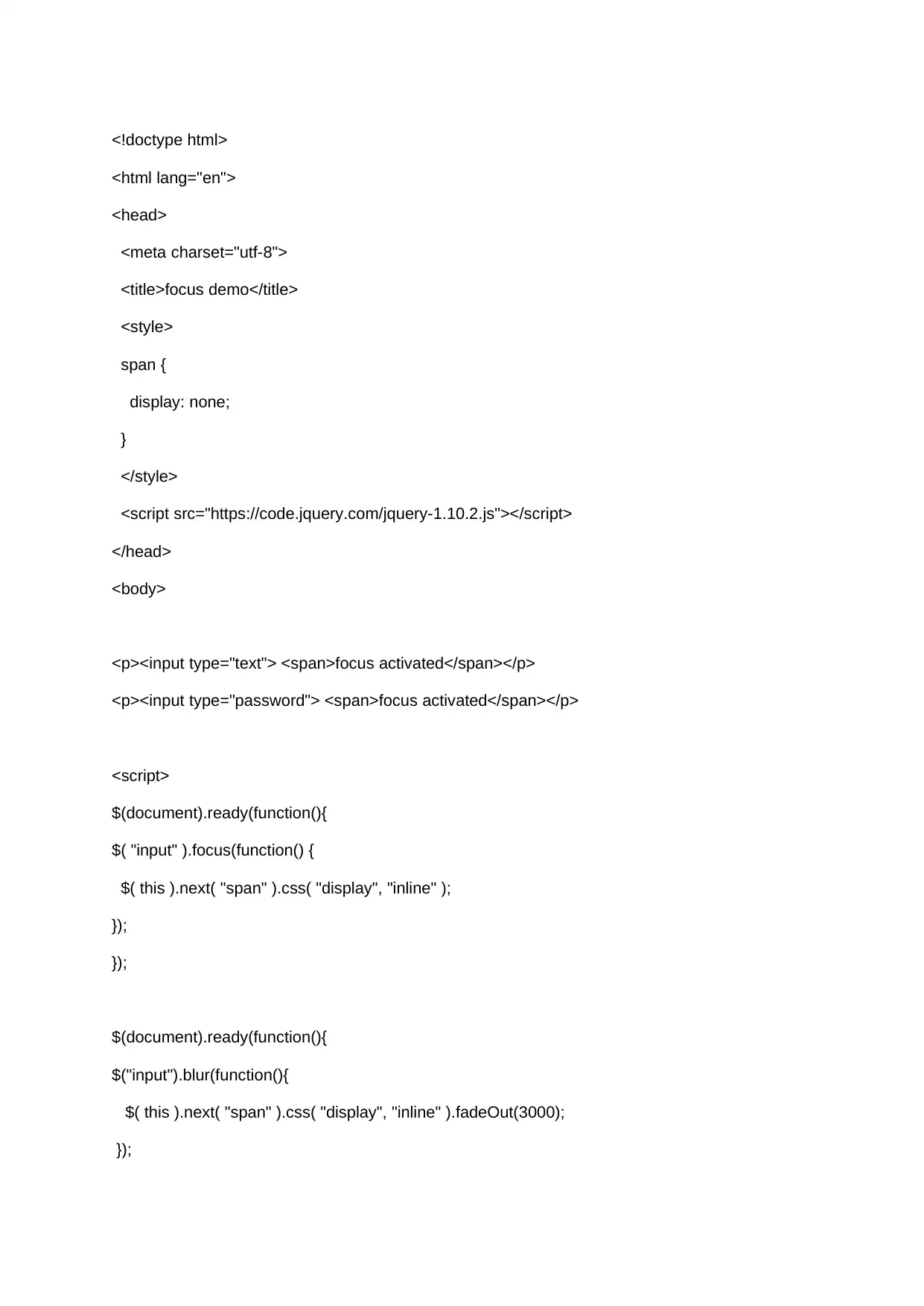
<!doctype html>
<html lang="en">
<head>
<meta charset="utf-8">
<title>focus demo</title>
<style>
span {
display: none;
}
</style>
<script src="https://code.jquery.com/jquery-1.10.2.js"></script>
</head>
<body>
<p><input type="text"> <span>focus activated</span></p>
<p><input type="password"> <span>focus activated</span></p>
<script>
$(document).ready(function(){
$( "input" ).focus(function() {
$( this ).next( "span" ).css( "display", "inline" );
});
});
$(document).ready(function(){
$("input").blur(function(){
$( this ).next( "span" ).css( "display", "inline" ).fadeOut(3000);
});
<html lang="en">
<head>
<meta charset="utf-8">
<title>focus demo</title>
<style>
span {
display: none;
}
</style>
<script src="https://code.jquery.com/jquery-1.10.2.js"></script>
</head>
<body>
<p><input type="text"> <span>focus activated</span></p>
<p><input type="password"> <span>focus activated</span></p>
<script>
$(document).ready(function(){
$( "input" ).focus(function() {
$( this ).next( "span" ).css( "display", "inline" );
});
});
$(document).ready(function(){
$("input").blur(function(){
$( this ).next( "span" ).css( "display", "inline" ).fadeOut(3000);
});
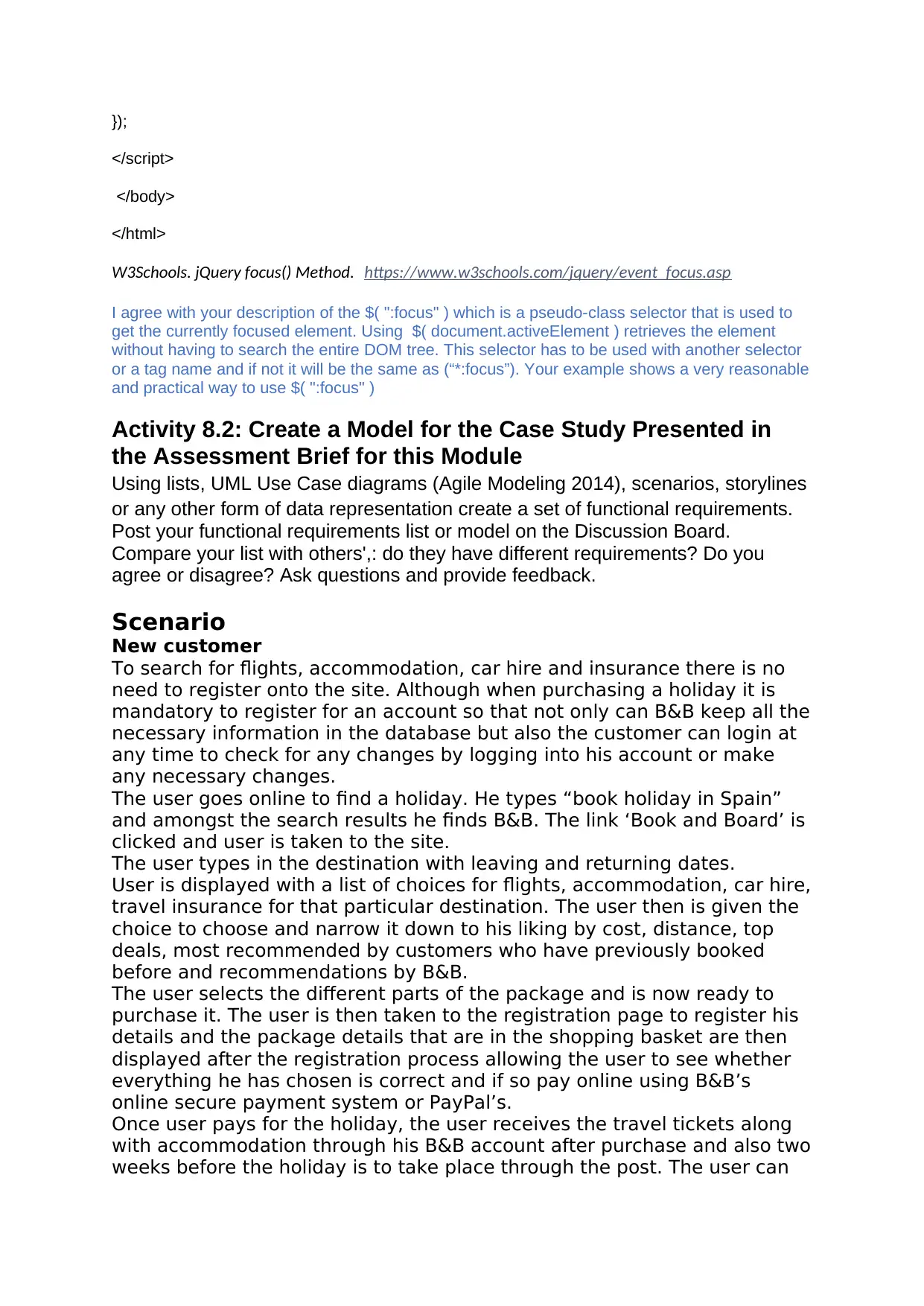
});
</script>
</body>
</html>
W3Schools. jQuery focus() Method. https://www.w3schools.com/jquery/event_focus.asp
I agree with your description of the $( ":focus" ) which is a pseudo-class selector that is used to
get the currently focused element. Using $( document.activeElement ) retrieves the element
without having to search the entire DOM tree. This selector has to be used with another selector
or a tag name and if not it will be the same as (“*:focus”). Your example shows a very reasonable
and practical way to use $( ":focus" )
Activity 8.2: Create a Model for the Case Study Presented in
the Assessment Brief for this Module
Using lists, UML Use Case diagrams (Agile Modeling 2014), scenarios, storylines
or any other form of data representation create a set of functional requirements.
Post your functional requirements list or model on the Discussion Board.
Compare your list with others',: do they have different requirements? Do you
agree or disagree? Ask questions and provide feedback.
Scenario
New customer
To search for flights, accommodation, car hire and insurance there is no
need to register onto the site. Although when purchasing a holiday it is
mandatory to register for an account so that not only can B&B keep all the
necessary information in the database but also the customer can login at
any time to check for any changes by logging into his account or make
any necessary changes.
The user goes online to find a holiday. He types “book holiday in Spain”
and amongst the search results he finds B&B. The link ‘Book and Board’ is
clicked and user is taken to the site.
The user types in the destination with leaving and returning dates.
User is displayed with a list of choices for flights, accommodation, car hire,
travel insurance for that particular destination. The user then is given the
choice to choose and narrow it down to his liking by cost, distance, top
deals, most recommended by customers who have previously booked
before and recommendations by B&B.
The user selects the different parts of the package and is now ready to
purchase it. The user is then taken to the registration page to register his
details and the package details that are in the shopping basket are then
displayed after the registration process allowing the user to see whether
everything he has chosen is correct and if so pay online using B&B’s
online secure payment system or PayPal’s.
Once user pays for the holiday, the user receives the travel tickets along
with accommodation through his B&B account after purchase and also two
weeks before the holiday is to take place through the post. The user can
</script>
</body>
</html>
W3Schools. jQuery focus() Method. https://www.w3schools.com/jquery/event_focus.asp
I agree with your description of the $( ":focus" ) which is a pseudo-class selector that is used to
get the currently focused element. Using $( document.activeElement ) retrieves the element
without having to search the entire DOM tree. This selector has to be used with another selector
or a tag name and if not it will be the same as (“*:focus”). Your example shows a very reasonable
and practical way to use $( ":focus" )
Activity 8.2: Create a Model for the Case Study Presented in
the Assessment Brief for this Module
Using lists, UML Use Case diagrams (Agile Modeling 2014), scenarios, storylines
or any other form of data representation create a set of functional requirements.
Post your functional requirements list or model on the Discussion Board.
Compare your list with others',: do they have different requirements? Do you
agree or disagree? Ask questions and provide feedback.
Scenario
New customer
To search for flights, accommodation, car hire and insurance there is no
need to register onto the site. Although when purchasing a holiday it is
mandatory to register for an account so that not only can B&B keep all the
necessary information in the database but also the customer can login at
any time to check for any changes by logging into his account or make
any necessary changes.
The user goes online to find a holiday. He types “book holiday in Spain”
and amongst the search results he finds B&B. The link ‘Book and Board’ is
clicked and user is taken to the site.
The user types in the destination with leaving and returning dates.
User is displayed with a list of choices for flights, accommodation, car hire,
travel insurance for that particular destination. The user then is given the
choice to choose and narrow it down to his liking by cost, distance, top
deals, most recommended by customers who have previously booked
before and recommendations by B&B.
The user selects the different parts of the package and is now ready to
purchase it. The user is then taken to the registration page to register his
details and the package details that are in the shopping basket are then
displayed after the registration process allowing the user to see whether
everything he has chosen is correct and if so pay online using B&B’s
online secure payment system or PayPal’s.
Once user pays for the holiday, the user receives the travel tickets along
with accommodation through his B&B account after purchase and also two
weeks before the holiday is to take place through the post. The user can
Secure Best Marks with AI Grader
Need help grading? Try our AI Grader for instant feedback on your assignments.
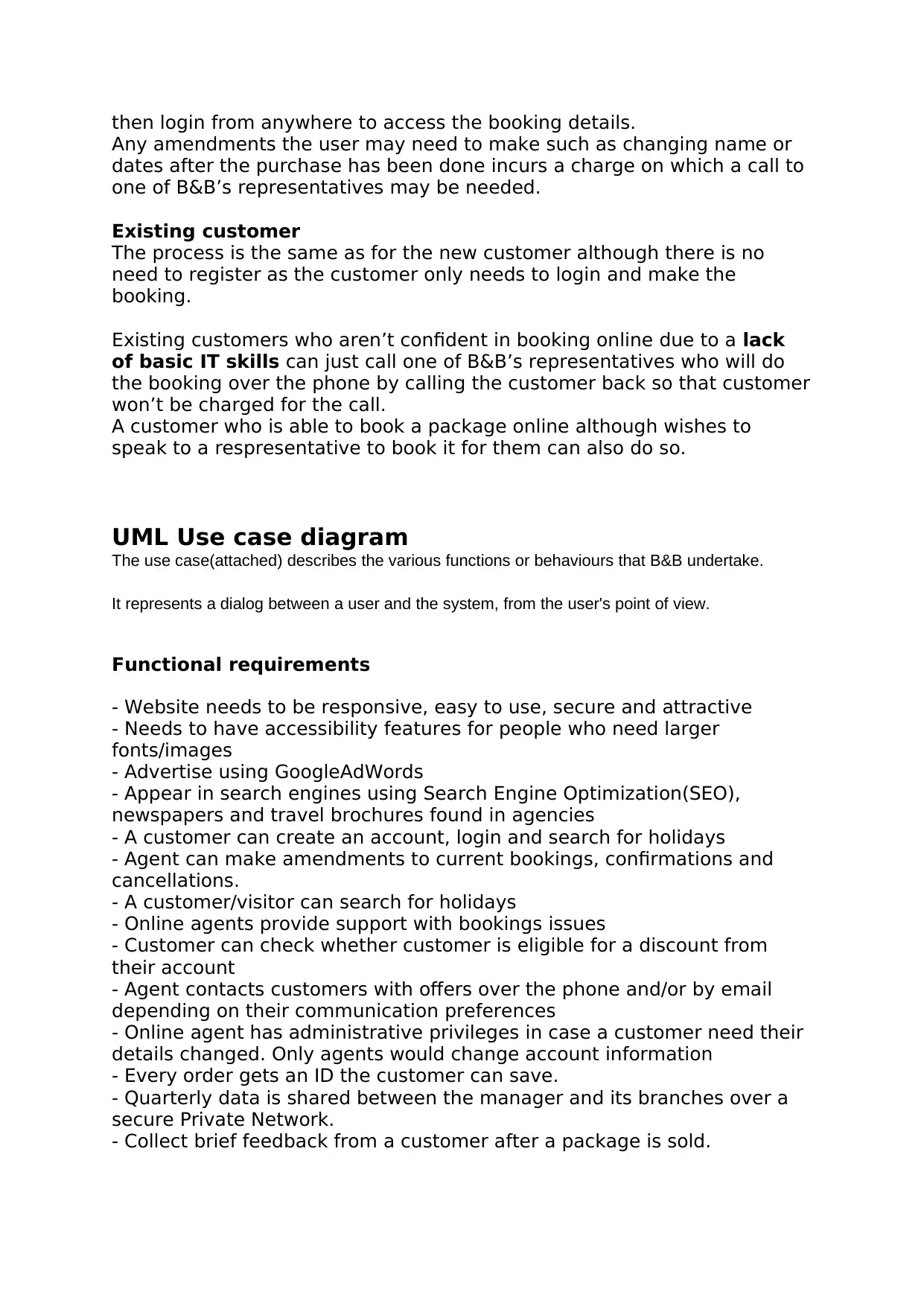
then login from anywhere to access the booking details.
Any amendments the user may need to make such as changing name or
dates after the purchase has been done incurs a charge on which a call to
one of B&B’s representatives may be needed.
Existing customer
The process is the same as for the new customer although there is no
need to register as the customer only needs to login and make the
booking.
Existing customers who aren’t confident in booking online due to a lack
of basic IT skills can just call one of B&B’s representatives who will do
the booking over the phone by calling the customer back so that customer
won’t be charged for the call.
A customer who is able to book a package online although wishes to
speak to a respresentative to book it for them can also do so.
UML Use case diagram
The use case(attached) describes the various functions or behaviours that B&B undertake.
It represents a dialog between a user and the system, from the user's point of view.
Functional requirements
- Website needs to be responsive, easy to use, secure and attractive
- Needs to have accessibility features for people who need larger
fonts/images
- Advertise using GoogleAdWords
- Appear in search engines using Search Engine Optimization(SEO),
newspapers and travel brochures found in agencies
- A customer can create an account, login and search for holidays
- Agent can make amendments to current bookings, confirmations and
cancellations.
- A customer/visitor can search for holidays
- Online agents provide support with bookings issues
- Customer can check whether customer is eligible for a discount from
their account
- Agent contacts customers with offers over the phone and/or by email
depending on their communication preferences
- Online agent has administrative privileges in case a customer need their
details changed. Only agents would change account information
- Every order gets an ID the customer can save.
- Quarterly data is shared between the manager and its branches over a
secure Private Network.
- Collect brief feedback from a customer after a package is sold.
Any amendments the user may need to make such as changing name or
dates after the purchase has been done incurs a charge on which a call to
one of B&B’s representatives may be needed.
Existing customer
The process is the same as for the new customer although there is no
need to register as the customer only needs to login and make the
booking.
Existing customers who aren’t confident in booking online due to a lack
of basic IT skills can just call one of B&B’s representatives who will do
the booking over the phone by calling the customer back so that customer
won’t be charged for the call.
A customer who is able to book a package online although wishes to
speak to a respresentative to book it for them can also do so.
UML Use case diagram
The use case(attached) describes the various functions or behaviours that B&B undertake.
It represents a dialog between a user and the system, from the user's point of view.
Functional requirements
- Website needs to be responsive, easy to use, secure and attractive
- Needs to have accessibility features for people who need larger
fonts/images
- Advertise using GoogleAdWords
- Appear in search engines using Search Engine Optimization(SEO),
newspapers and travel brochures found in agencies
- A customer can create an account, login and search for holidays
- Agent can make amendments to current bookings, confirmations and
cancellations.
- A customer/visitor can search for holidays
- Online agents provide support with bookings issues
- Customer can check whether customer is eligible for a discount from
their account
- Agent contacts customers with offers over the phone and/or by email
depending on their communication preferences
- Online agent has administrative privileges in case a customer need their
details changed. Only agents would change account information
- Every order gets an ID the customer can save.
- Quarterly data is shared between the manager and its branches over a
secure Private Network.
- Collect brief feedback from a customer after a package is sold.
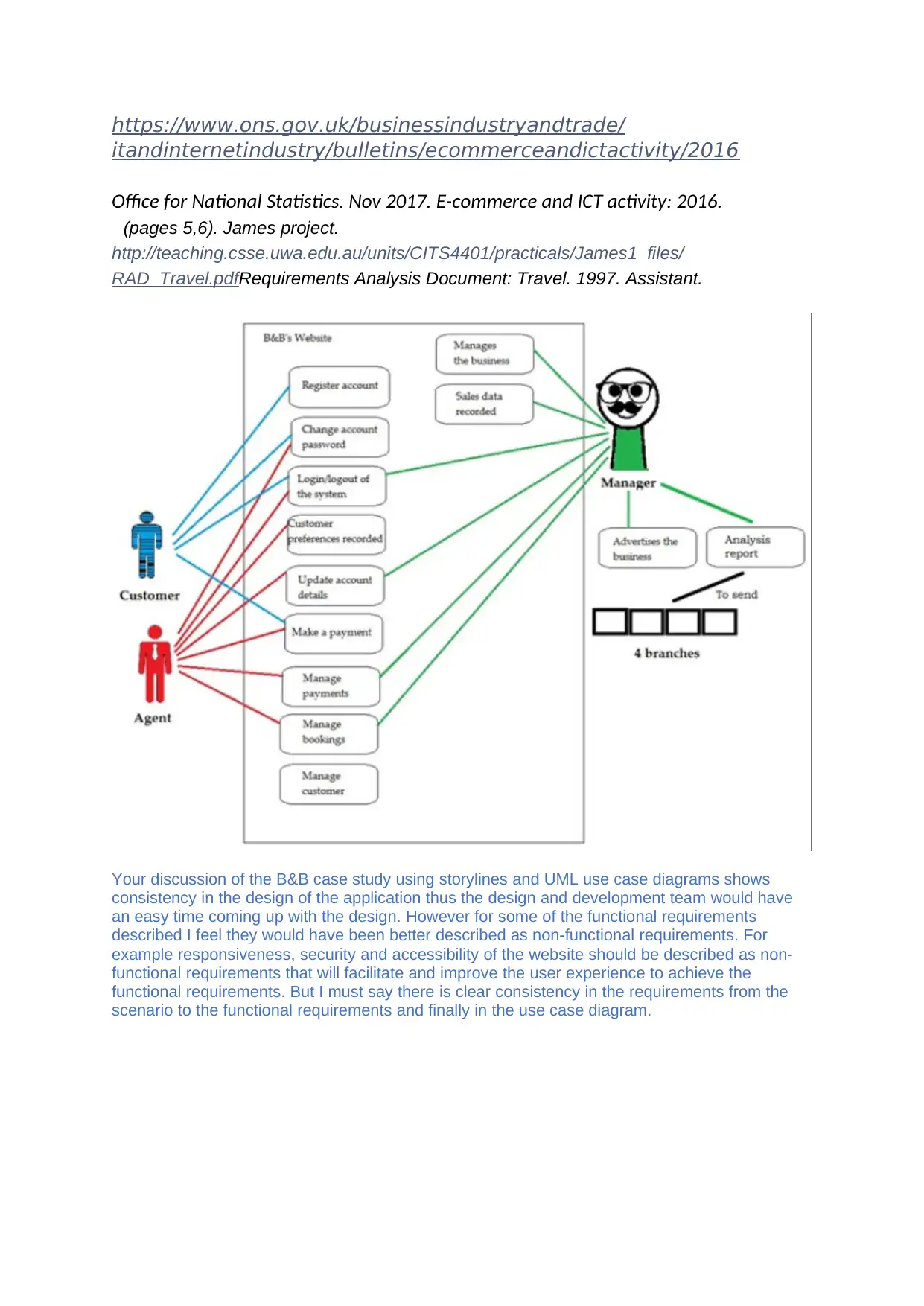
https://www.ons.gov.uk/businessindustryandtrade/
itandinternetindustry/bulletins/ecommerceandictactivity/2016
Office for National Statistics. Nov 2017. E-commerce and ICT activity: 2016.
(pages 5,6). James project.
http://teaching.csse.uwa.edu.au/units/CITS4401/practicals/James1_files/
RAD_Travel.pdfRequirements Analysis Document: Travel. 1997. Assistant.
Your discussion of the B&B case study using storylines and UML use case diagrams shows
consistency in the design of the application thus the design and development team would have
an easy time coming up with the design. However for some of the functional requirements
described I feel they would have been better described as non-functional requirements. For
example responsiveness, security and accessibility of the website should be described as non-
functional requirements that will facilitate and improve the user experience to achieve the
functional requirements. But I must say there is clear consistency in the requirements from the
scenario to the functional requirements and finally in the use case diagram.
itandinternetindustry/bulletins/ecommerceandictactivity/2016
Office for National Statistics. Nov 2017. E-commerce and ICT activity: 2016.
(pages 5,6). James project.
http://teaching.csse.uwa.edu.au/units/CITS4401/practicals/James1_files/
RAD_Travel.pdfRequirements Analysis Document: Travel. 1997. Assistant.
Your discussion of the B&B case study using storylines and UML use case diagrams shows
consistency in the design of the application thus the design and development team would have
an easy time coming up with the design. However for some of the functional requirements
described I feel they would have been better described as non-functional requirements. For
example responsiveness, security and accessibility of the website should be described as non-
functional requirements that will facilitate and improve the user experience to achieve the
functional requirements. But I must say there is clear consistency in the requirements from the
scenario to the functional requirements and finally in the use case diagram.
1 out of 12
Your All-in-One AI-Powered Toolkit for Academic Success.
+13062052269
info@desklib.com
Available 24*7 on WhatsApp / Email
![[object Object]](/_next/static/media/star-bottom.7253800d.svg)
Unlock your academic potential
© 2024 | Zucol Services PVT LTD | All rights reserved.